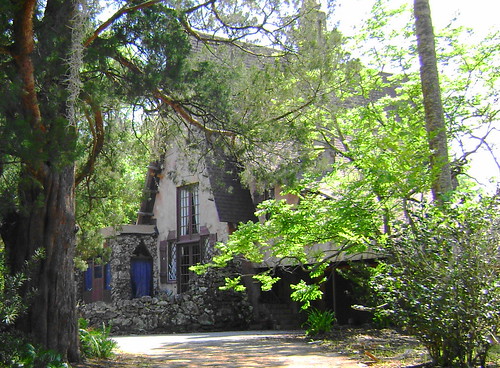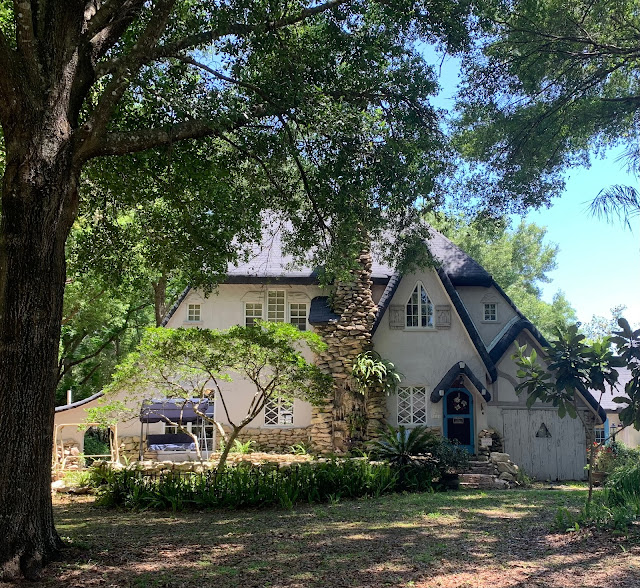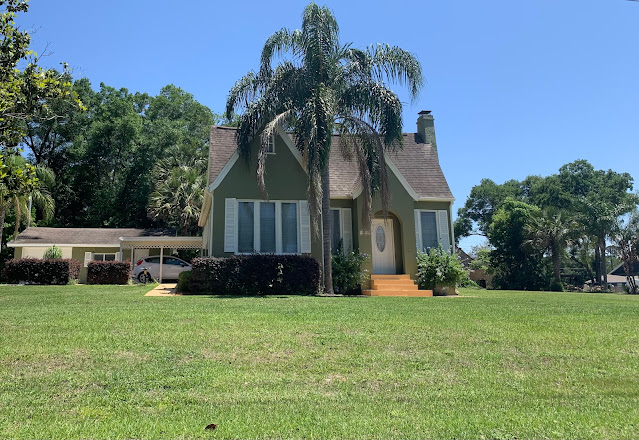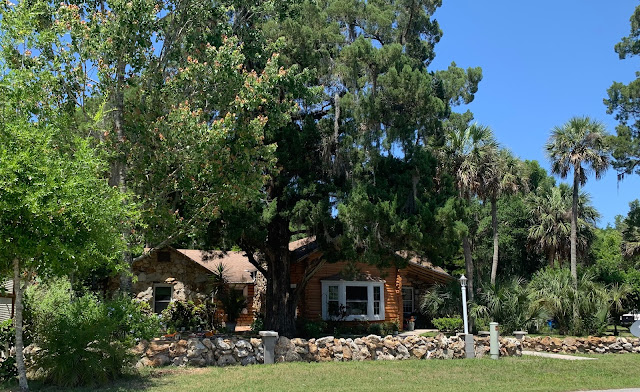Article Extensively Updated on April 16, 2022
 Imagine finding this house on an otherwise ordinary
street! Hansel and Gretel would feel right at home here. Or Snow White and the
Seven Dwarfs, and all of their singing woodland furry and feathered friends.
Imagine finding this house on an otherwise ordinary
street! Hansel and Gretel would feel right at home here. Or Snow White and the
Seven Dwarfs, and all of their singing woodland furry and feathered friends.Actually, the home is a creation of the Central Florida artist, architectural designer, and developer, Sam Stoltz. He named the house The Plymouthonian (Number 2). Here is what he had to say about it...
"Nature confines her lines entirely to curves. Mount Plymouth, with its beautiful hills and valleys is full of curves. When we created The Plymouthonian, we followed the teachings of the old masters and modern artists, eliminating the usual harsh lines and produced a type of home in keeping with its surroundings, just as if it grew there - a part of landscape." - Sam Stoltz
There was actually a Plymouthonian No. 1; it was built for Virgil Bolyard of Indianapolis, Indiana. But it burned down in 1927. The Plymouthonian No. 2 is pictured here.
For an interior view (not by me) click this link:
extimages2.living.net/ImagesHomeProd3/FL/idx/photos/midfl...
The house is currently for sale. Mount Plymouth is a charming town but it has seen better days. The "St. Andrews" golf course is closed, ever since 2007. Before the resort hotel there burned down, it was the stopping place of famous people like Babe Ruth, Connie Mack, Johnny Weissmuller ("Tarzan"), Maurine O'Sullivan ("Jane", Mia Farrow's mom ), John and Pierie (of the Chicago department store family), Graves Whitmire (Chicago newspaper owner), Lester Beeman (Chicago chewing gum magnate - think "Black Jack" gum), Joe Tinker, Walter Hagan, Mickey Mantle, and Kate Smith. If you have to ask who Kate Smith was, look her up and listen to her sing "God Bless America!"
T
he Plymouthonian No. 2 is said to have been Al Capone's bookkeeper's home for a
time and Al is said to have been a frequent visitor. The listing agent has
looked but could not find the "rumored tunnels." The story is probably based in truth; the Chicago "Outfit" was heavily invested in the development of Mount Plymouth. This may be one reason why its history has been a tad obscure until recently. The people who "knew" kept quiet about it. Of course, by now anyone who was developing a Florida neighbored in the 1920s is long gone.
Unique features include the Stoltz bird murals, the pecky cypress and stone floors and the curb appeal that sets the house apart from others houses. Anne has a special affinity for Sam's work. Anne, Steven, and I toured this house when the current owners / artists had it on an arts tour of Lake County. We were delighted to see it up close and personal.
* * * * * *
Here are the ways the 2012 listing agent described the house:
The PLYMOUTHONIAN No. 2 - historical artistic creation by the renowned Builder Sam Stoltz depicting the history of Florida! Soaring 45 ft. Chimney; Stone and Wood Floors; Cypress Beams; Architectural Designs ; This beautiful 'historical' residence is enlivened by a fountain and a rustic interior stone fireplace w/ round plaster relief inset featuring a bird; wonderful colored and textured artistic walls; hammered metal chandelier; wood balusters of wavy irregular shapes; Mexican tile & Gothic archways in the bathrooms.
The Plymouthonian No. 2 is described as surpassing anything Stoltz had created, including half timbering in the gable ends, pointed window heads & rough stone trim and chimney. Many prominent persons have owned and occupied several of Sam Stoltz's homes, including 'Muppeteer Jim Henson' in Windermere!
Art and Life abound in this unique 'Tudor Style' fascinating architecture pronounced as one of the most artistic 'Old World to the Modern New in the 1920's'. The builder's fascination with the birds and fauna of Florida led him to embellish his homes with depictions of herons, flamingos, fauna - sculpted in plaster relief and stucco. In-Law Suite; Workshop 40X20; Pole Barn 30X24.
Orlando Sentinel reported...in the late 1920's, Builders 'success' is a new departure with mural decorative painting, depicting the History of Florida. This magnificent Estate Home is 'Tudor-derived with Fairyland' as a theme, and 'Tudor Revival' as the style.
For a photo when the house was new (not by me) see this link:
books.google.com/books?id=r5As5ABg1REC&pg=PA51&lp...
It would be nice to know if there was a connection between Sam Stoltz's ideas and the well-known Spadena House (also known as "The Witch's House"), in Beverley Hills, shown below. Maybe one belonged to the Witch of the East and the other to the Witch of the West?:

Sam Stoltz was born in Nebraska to parents who had moved there from Pennsylvania. His Pennsylvania Dutch origins are evident in his surname, "Stoltz" which is a shortened version of the very familiar "Stoltzfus" of Central Pennsylvania. Sam was a gifted artist. And a larger than life character who enjoyed sporting plus fours with coordinated hose and vests. He and his wife Patti relocated to Central Florida in 1925, and it was full steam ahead in creating fantasy homes for adventurous clients. Today, they contribute tremendously to the architectural heritage of the Orlando area.
There is some indication that Central Florida's pioneering woman architect Ida Annah Ryan collaborated with Sam Stoltz on some of his architectural designs. Whether her partner Isabel Roberts shared in this effort is not yet known, but it is highly likely. Perhaps Ryan provided the architectural "stamp" or other professional expertise.
Regarding Mount Plymouth, (Hanford) Carl Dann was the developer and Sam Stoltz, his friend, designed the hotel and 18 residences. Some of the houses remain, some have been remodeled to the point of being unrecognizable, and some have been torn down to make way for newer, nondescript houses. Sigh. Progress often gets in the way of our enjoyment of artistic creativity, doesn't it? Mount Plymouth Hotel was only open during the "season" (Christmas through Easter) - guest could arrive in style using the private airstrip. The hotel patrons were not only notable, they were highly affluent, many were members of the Chicago crowd.
Life is too short not to enjoy being out of the ordinary. Sam Stoltz knew that, and helped others to achieve that intangible goal with the choices they made for their homes and other buildings. Whether in the Spanish Revival (Sam called it "Spanish Orlando" or"Florida Spanish"), or a Woodland Lodge Style (of which Dubsdred Country Club is a fine example). or his over-the-top picturesque storybook cottages (sometimes dubbed "Tudor Revival"), they were noticeable and popular in the 1920s and 1930s, and have remained so. It is not every client who will "go for" a Sam Stoltz residence, but for those who do, every day is like a fairy tale!
Architecture by Sam Stoltz (1876-1952).
Open to the public; you can visit and enjoy a meal there during their hours of operation:
- Historic Dubsdred Country Club Clubhouse, College Park, Florida
In spotlighting the work of Sam Stoltz we want to look at a place that is easily accessible to the general public, both outside and in. That is frankly hard to find. Most of Stoltz’s work was residential and continues to be enjoyed by private owners today. We would never recommend anything but a passing glance from the public street or sidewalk at these many private residences. Be very respectful if you go out looking at them. But Dubsdred welcomes diners to the clubhouse Tap Room grill, and if you ask very nicely, they will let you take a look at the ballroom, which is the best-preserved portion of the building from the Sam Stoltz era.
Dubsdred Country Club is of the “Woodland Lodge Style” of Sam Stoltz’s work. One of three general aesthetics he chose to work in. The Woodland Lodge Style usually has wood siding, simple gable roof forms, stone chimneys, exterior porches, grouped windows and French doors These are hallmarks of Dubsdred, as we see it today, as well as other notable buildings in this style: the Carl Dann Residence (AKA "Dann Ranch", 3206 Greens Avenue, Winter Park, Florida - 1935.) and Carl Dann’s vacation home at 25343 Troon Avenue, Mount Plymouth, Sorrento, Florida - 1926, among others. Those who lived in or visited such structures were to have a sense of getting away from it all, in the dappled shade of the forest, amid the quiet and beauty of nature.
Stoltz loved using coquina stone as perimeter landscaping walls, or incorporated in to the building itself. At Dubsdred, the huge and handsome chimney is a fine example of this penchant for utilizing native stone as a natural, organic feature.
Private Homes - Please be super-respectful and view from the public street, only:
- Stoltz Residence I, 1318 Eastin, College Park - 1926
- 1322 Eastin, College Park. This lovely 1920s home has an unexpected color scheme, but it does not obscure the many Sam Stoltz preferred Florida Spanish elements: Barrel tile roof, stucco walls, round headed windows and door, Juliet balcony, french doors, and whimsical window placement.
- Robert Fox Residence, 1314 Eastin, College Park - 1926. Barrel tile roof, round headed openings, Juliet balcony, decorative parapet, and stucco exterior all all expected elements of Sam Stoltz's Florida Spanish style.
- Miles Dawson Residence, 868 Golfview Terrace, Winter Park, Florida
- 843 Palmer Avenue, Winter Park, Florida A lovely Tudor Revival, complete with cat slide, rounded door and windows, prominent chimney, French doors, and sculptural details including the confine rock around the front door (a Sam Stoltz favorite). Although this house is well maintained, the color scheme does not show off the architecture to the best effect. One suspects the half circle recess above the windows in the gable once held a Stoltz bas relief sculpture. I can almost hear the conversation. Painter: "Hey folks what do you want me to do about that bird mural?" Homeowners: "Scrape it off or spackle over it; we've never much liked it." (Sigh).
Oh, you are wondering about my color recommendations? Roof in a medium to dark grey to brown slate look. Walls painted the palest beige or parchment color (satin, not glossy, this is Florida folks, you do not want your house reflecting like a mirror). Trim windows and door surrounds, in a medium to dark charcoal or sienna depending on the other color choices. Front door? The ladies lounge pink has got to go. Best solution, refinished in its natural wood (I am sure it is under there); or short of that, dark forest green or dark navy blue (glossy). Tera cotta, black, or dark brown are other possible choices. The chimney pots and projecting round tiles point you in the tera cotta direction naturally. Match them in the door color and the whole facade will sing. Oh, and restore the Stoltz mural in the half circle, please.
- 533 Greeley, College Park, Florida. Here's a lesson in how to make the most of a modest home. Stucco exterior, pent roof over the french doors, curved headed windows, cat slide with arched garden gate, and side entry providing an entry terrace, are all elements that set this home apart from the ordinarily. Best of all is the Sam Stoltz half circle bas relief of birds in flight. It is a petite version of the Stoltz House I at 1318 Eastin. 

- Stoltz Residence II, 610 Greeley, College Park - 1928. Here the Orlando Spanish Revival is expressed in the barrel tile and stucco exterior, the round headed windows, Juliet balcony, rounded garden entry, and whimsical window placement. The half-circle niche in the parapet has a very lovely Sam Stoltz bas relief sculpture of birds in flight.
- 406 Niblick, College Park, Florida (in collaboration with Ida Annah Ryan and Isabel Roberts, probably). This simplified Spanish Revival style has some expected elements such as the stucco exterior, decorative parapet (which once held a Stoltz bas relief sculpture, barrel tile roof, rounded entry porch, mission style curves, and round headed and grouped widows. A charming detail is the use of urns on the parapet ends.
- College Park, Florida"
- Carl Dann Residence (AKA "Dann Ranch"), 3206 Greens Avenue, Winter Park, Florida - 1935. This magnificent and beautifully situated home remained in the Dann family for nearly a century. The design is very much in the woodland lodge style that Stoltz also used on Dubsdred Country Club and elsewhere.
- Private Residence (for a time, Rollins College Music Conservatory's Martin Hall. Recently much altered and added on to, and again a private residence), Most of the "character" fo this house disappeared in the remodeling. Notably the exterior Sam Stoltz relief sculpture in the central pediment. 1000 Genius Drive, Winter Park, Florida. These vintage photos show how it looked, originally:
- 515 Ridgewood Drive, Windermere, Florida - 1934 (on a heavily landscaped lot, impossible to view in any detail)
- "Piney Green" The Horne / Nicholson / Brock Residence, 1018 E. Livingston Street, Orlando, Florida - 1934 (one of the woodland lodge style homes; loving tended by its current owners)
- The Mount Plymouth Hotel, Mount Plymouth, Florida (destroyed by fire in 1983)
Finally, we come to a wonderful collection of 18 houses in Mount Plymouth. They appear, below. The location is Mount Plymouth but the street addresses are for Sorrento, the nearest post office. The houses vary from Woodland Lodge Style, to Florida Spanish / Mediterranean Revival, to Tudor Revival, (whether very modest, slightly restrained, or of course the most easily discovered storybook style). In Mount Plymouth, Stoltz showed the same versatility as in Orlando, College Park, and Winter Park, with homes of various styles and sizes.
The following have been identified, thus far:
- Virgil Bolyard House, Plymothonian Number 1, destroyed by fire in 1927
- The Plymohonian Number 2, 30801 Ridgeview, Mount Plymouth, Sorrento, Florida. (lovingly cared for by the current artist/owners who sometimes open the house on Christmas time tours)
- Plymouthonioin No. ?, 30308 County Road 435, Sorrento, Florida - 1926. Favorite Sam Stoltz features include the cat-slide, coquina stone for the chimney and garden wall, Tudoresque gables, wrapped roof emulating thatch, stucco exterior, whimsical window placement, and garden archway.
- The Cornelius House, Plymouthonion No. ?, 31121 Interlanchen Drive at the 10th fairway, Mount Plymouth, Florida. Sam Stoltz told Oscar Torbert that he built the chimney "so crooked on this one" that no one would buy it. Even so, word of mouth says that a man named George Cornelius bought it because he liked the chimney on this home more than any of the others. Bolyard and Cornelius were partners in the oil business. George Cornelius was a partner with Virgil Bolyard of Plymothonian Number 1, in the oil business. Typical Sam Stoltz storybook design elements linclude the gables, half timbering, diamond pane windows, stucco exterior, wrapped roof emulating thatch, coquina stone chimney, cat-slides, and whimsical window placement. The garage is a later addition. The original one car garage was to the right of the front door (the garage door is still there). Somewhat hard to view because of the wonderful landscaping, this is one of the best-preserved Plymouthonians:
- Plymouthonian Number ?, 30852 Westward Ho Avenue, Mount Plymouth, Sorrento, Florida. A modest tudoresque cottage ornee, with two different gable ends on the front facade, and a round entry porch:
- 31151 Overbrook Street, Plymothonian Number ?, Mount Plymouth, Sorrento, Florida. Beautiful Italian Villa Revival style, including the stucco exterior, barrel tile roof, round headed windows and entry porch, and the Juliet balcony. There is a lovely collection of Sam Stoltz tropical birds in the gable end over the front entry, see the detail photo:
- Plymouthonian Number ?, 25411 Carnoustie Drive, Mount Plymouth, Sorrento, Florida. Although this house has been much remodeled, (and is in very nice condition), the Sam Stoltz original features include the gables, the rusticated (now, painted) coquina stone chimney, and the grouped curve top windows reminiscent of a similar design on 533 Greeley Street in College Park. Presumably, the original exterior was stucco. The country charm porch is of course not original.
- 30943 Deal Drive, Mount Plymouth, Sorrento, Florida - 1926. A modest tudoresque cottage ornee, with a gable end and slant roofed dormer on the front facade:
- 30835 Deal Drive, Mount Plymouth, Sorrento, Florida - 1930. Essentiall the mirror image of the house shown above. Another modest tudoresque cottage ornee, with a gable end, and a slant roof dormer. The entry porch has been enclosed. The dressed stone exterior may be a later renovation:
- Plymouthonian Number ?, 30825 County Road 435, Mount Plymouth, Sorrento, Florida. This house is beautifully located as you enter Mount Plymouth from the south, on the left side of the road. Even without slowing down much, you get a lovely look at it. Stoltz design elements include the stucco exterior, non-matching forward facing gables, curved roofline over the entry porch, cat slide, and the side-entry front door, which he used on his own house on Eastin Avenue in College Park.
- Carl Dann Vacation Home, 25343 Troon Avenue, Mount Plymouth, Sorrento, Florida - 1926. Some experts on Sam Stoltz will be surprised that this is one of his designs It is one of his Woodland Lodge style homes. The clue for passers by is the coquina stone wall at the front of the property, one of Stoltz's trademarks. This home has affinities to Carl Dann's home in Orlando, "Dann's Ranch" as well as the country club he developed in College Park, Dubsdread Country Club, and the Piney Green house in Orlando. Interestingly, Piney Green Road intersects Troon Avenue nearby, and Dubsdread Avenue is another named street in the Mount Plymouth development. Carl Dann was the Mount Plymouth real estate developer and promotor - this is his own home. The woodland lodge style Sam Stoltz houses are 'sleepers', in that they are less dramatic than the Florida Spanish and Storybook Tudor Revival homes (which regularly turn heads). Whether or not Sam dubbed this one a Plymothonian is not yet known. Wood sided, simple gable roof forms, stone chimney, exterior porches, and grouped windows are usual details of Stolt's woodland lodge style.
- "Blarney Castle", Plymouthonian Number ?, (no longer standing). The three story witch's hat tower is the main feature of this house, along with the coquina stone fireplace. Coquina stone comprises potions of the walls as well as the garden walls.
I have enjoyed creating this list of Sam Stoltz's designs, searching property records and other similar leads. If you wish to include the list, or portions of it, in your own publications, please give me credit.
This list is incomplete. You can help add to it, if you know of buildings by Sam Stoltz. Just send me a message, thanks!









































































3 comments:
Wow, thank you so much for creating such a great collection of his work! I have always been fascinated by Sam Stoltz' homes, as I a Central Florida native. Growing up in Orlando in the 90's I saw how all our homes became cookie cutter. My Father was a roof truss designer and together we would still marvel at the houses with character. I have never found a webpage before that listed so many of Sam's work. I can't thank you enough for finding all these! I hope to one day step inside one of his masterpieces!
I am so pleased and happy to find this excellent compendium of Sam Stoltz. He was two years older than my great-grandfather, William F. Stoltz. A picture of the family taken about 1895 is at this address
https://www.ancestry.com/sharing/862327?mark=dab4a7c7a70e4f7b907a3d2b0b6f552a30971960d739725318.0339cb43d56da6
Sam is the handsome man in the second row, furthest right (my great-grandfather, "Will" is the boy on the left of the back row). We can be certain that this picture is before 1896, because the toddler, Martin, in the front row, held by his father, died at the age of five in 1896.
I continue to find more and more information about the Stoltz family. Such as, Sam had been previously married in Chicago, and Sam's brother Jacob married the sister of Sam's business associate in Kalamazoo, Lockwood, the socialist.
Of Sam, my great-grandfather wrote, "Sam did not care for farming at all. He was artistic and wanted to be an artist.... Some place on most of these buildings you will find his mark. The cardinal bird was his accepted trademark." These quotes come from a rather lengthy article William F. contributed to "Folklore of a Pennsylvania colony in Nebraska." 1955. Incidentally, William F. stayed on the family farm, which was lost in the Great Depression due to an ill-timed mortgage. He moved to Silverton, Oregon after the start of WWII to work in the lumber industry. He outlived all of his siblings.
Robert L. Stoltz, son of James R. Stoltz (dec.), son of Carroll F. Stoltz, son of William F. Stoltz.
Thanks for a great read. We have bought pottery from the artist living in # 2 for many years. On a visit to Winter Park today we came upon a beautiful Sam Stoltz painting of a deer in the forest and are so excited to have purchased it. I'd be happy to send a picture of. His art was equally beautiful!
Post a Comment